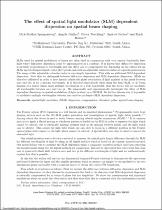 ResearchSpace
ResearchSpace
The effect of spatial light modulator (SLM) dependent dispersion on spatial beam shaping
JavaScript is disabled for your browser. Some features of this site may not work without it.
- ResearchSpace
- →
- Research Publications/Outputs
- →
- Conference Publications
- →
- View Item
| dc.contributor.author |
Spangenberg, D-M

|
|
| dc.contributor.author |
Dudley, Angela L

|
|
| dc.contributor.author |
Neethling, P

|
|
| dc.contributor.author |
Forbes, A

|
|
| dc.contributor.author |
Rohwer, E

|
|
| dc.date.accessioned | 2014-08-06T09:36:26Z | |
| dc.date.available | 2014-08-06T09:36:26Z | |
| dc.date.issued | 2013-08 | |
| dc.identifier.citation | Spangenberg, D-M, Dudley, A.L., Neethling, P, Forbes, A and Rohwer, E. 2013. The effect of spatial light modulator (SLM) dependent dispersion on spatial beam shaping. In: Proceedings of SPIE, Volume 8843, Laser Beam Shaping XIV, San Diego, California, United States, 25-29 August 2013 | en_US |
| dc.identifier.uri | http://spie.org/Publications/Proceedings/Paper/10.1117/12.2023286 | |
| dc.identifier.uri | http://hdl.handle.net/10204/7562 | |
| dc.description | Proceedings of SPIE, Volume 8843, Laser Beam Shaping XIV, San Diego, California, United States, 25-29 August 2013 | en_US |
| dc.description.abstract | SLMs used for spatial modulation of lasers are often used in conjunction with very narrow bandwidth laser light where diffractive dispersion could be approximated as a constant. It is known that diffractive dispersion is inversely proportional to wavelength and this effect can be compensated for depending on the optical set-up. SLMs use birefringent liquid crystal (LC) pixels each with an adjustable refractive index at a specific polarization. The range of the adjustable refractive index is wavelength dependent. This adds an additional SLM dependent dispersion. Note that we distinguish between diffractive dispersion and SLM dependent dispersion. SLMs are therefore calibrated in order to have linearly adjustable phase retardation of light incident on the pixels between zero and two pi for a specific wavelength. It is therefore unavoidable when using the same SLM, to do beam shaping of a source which emits multiple wavelengths or a wide bandwidth, that the device will not modulate all wavelengths between zero and two pi. We numerically and experimentally investigate the effect of SLM dependent dispersion on spatial modulation of light incident on a 2D SLM. We further discuss why it is possible to modulate multiple wavelengths between zero and two pi despite SLM dependent dispersion. | en_US |
| dc.language.iso | en | en_US |
| dc.publisher | SPIE Proceedings | en_US |
| dc.relation.ispartofseries | Workflow;13101 | |
| dc.subject | Spatial light modulator | en_US |
| dc.subject | SLM | en_US |
| dc.subject | Spatial beam shaping | en_US |
| dc.subject | Laser modulation | en_US |
| dc.title | The effect of spatial light modulator (SLM) dependent dispersion on spatial beam shaping | en_US |
| dc.type | Conference Presentation | en_US |
| dc.identifier.apacitation | Spangenberg, D., Dudley, A. L., Neethling, P., Forbes, A., & Rohwer, E. (2013). The effect of spatial light modulator (SLM) dependent dispersion on spatial beam shaping. SPIE Proceedings. http://hdl.handle.net/10204/7562 | en_ZA |
| dc.identifier.chicagocitation | Spangenberg, D-M, Angela L Dudley, P Neethling, A Forbes, and E Rohwer. "The effect of spatial light modulator (SLM) dependent dispersion on spatial beam shaping." (2013): http://hdl.handle.net/10204/7562 | en_ZA |
| dc.identifier.vancouvercitation | Spangenberg D, Dudley AL, Neethling P, Forbes A, Rohwer E, The effect of spatial light modulator (SLM) dependent dispersion on spatial beam shaping; SPIE Proceedings; 2013. http://hdl.handle.net/10204/7562 . | en_ZA |
| dc.identifier.ris | TY - Conference Presentation AU - Spangenberg, D-M AU - Dudley, Angela L AU - Neethling, P AU - Forbes, A AU - Rohwer, E AB - SLMs used for spatial modulation of lasers are often used in conjunction with very narrow bandwidth laser light where diffractive dispersion could be approximated as a constant. It is known that diffractive dispersion is inversely proportional to wavelength and this effect can be compensated for depending on the optical set-up. SLMs use birefringent liquid crystal (LC) pixels each with an adjustable refractive index at a specific polarization. The range of the adjustable refractive index is wavelength dependent. This adds an additional SLM dependent dispersion. Note that we distinguish between diffractive dispersion and SLM dependent dispersion. SLMs are therefore calibrated in order to have linearly adjustable phase retardation of light incident on the pixels between zero and two pi for a specific wavelength. It is therefore unavoidable when using the same SLM, to do beam shaping of a source which emits multiple wavelengths or a wide bandwidth, that the device will not modulate all wavelengths between zero and two pi. We numerically and experimentally investigate the effect of SLM dependent dispersion on spatial modulation of light incident on a 2D SLM. We further discuss why it is possible to modulate multiple wavelengths between zero and two pi despite SLM dependent dispersion. DA - 2013-08 DB - ResearchSpace DP - CSIR KW - Spatial light modulator KW - SLM KW - Spatial beam shaping KW - Laser modulation LK - https://researchspace.csir.co.za PY - 2013 T1 - The effect of spatial light modulator (SLM) dependent dispersion on spatial beam shaping TI - The effect of spatial light modulator (SLM) dependent dispersion on spatial beam shaping UR - http://hdl.handle.net/10204/7562 ER - | en_ZA |





